By Linda Williams, Forest Health Specialist, Woodruff;
Linda.Williams@wisconsin.gov, 920-360-0665
What can learn new things, move toward and acquire food, remember where food was and what foods are preferred, figure out the shortest route through a maze, remember where it has traveled and seem to disappear as quickly as it first appeared?
It’s slime mold, of course!
The name “slime mold” may sound icky, but these colorful blobs are more fascinating than most might realize.
Originally thought to be related to fungi, slime molds are now classified into the taxonomic kingdom Protista. They are “amoeba-like” without cellular walls, allowing them to engulf their food through a process known as phagocytosis. Slime molds can move toward food, crawling over and around things, and can move as much as one inch per hour. Slime mold cells can combine to create a larger “blob” called a plasmodium, “remember” where they have been and effectively transform themselves into structures necessary for various life stages. A study conducted by Harvard and Tufts universities even showed that slime mold will purposefully grow toward a non-food structure.
They come in many different shapes and colors, so you might not realize when you’re looking at a slime mold. Many people may be familiar with the (apologies in advance) “dog vomit” slime mold, which gets its name from its appearance. These molds typically grow on woodchips or decaying wood, as slime molds usually feed on the bacteria found in/on wood, although some feed on protozoa, fungi and yeasts.
Mystery And Surprises
The biology of slime molds is complicated. Slime molds can appear quite suddenly one day, even if nothing was noticeable the day before. These large, showy blobs, called plasmodia, are made of a single, large, multi-nuclear organism without a cell wall.
Plasmodia are slime molds in their feeding and moving stages, and are often found on lawns, small plants, mulch and decaying wood in the late summer. In the plasmodium stage, slime molds create an interconnected network of tubes resembling veins, allowing protoplasm to stream and move. If observed over time, the plasmodium pulses as it pushes cytoplasm to move toward food.
Slime molds are considered either cellular or plasmodial, and each has some unique aspects of their life cycles. Cellular slime molds spend most of their life cycles as individual single cells that act like amoebas — but when starving, they can send out chemical signals that call for a mass congregation. Those single cells join together to form a “slug,” which can travel more easily to new areas with more food. There, they will then produce spores. Plasmodial slime molds can be larger, with many hundreds of nuclei in a single large cell that will stream in a direction of choice.
If slime molds dry out too quickly, they produce sclerotia, like resting cells, with thick walls that can resist drying. These sclerotia can remain in the environment for long periods of time waiting for the right conditions to occur, at which time they can once again become a plasmodium form of the slime mold.
Generally, slime molds are not problematic enough to warrant any control, and most are not plant parasites but may injure plants by covering and shading them.
If slime molds are in a place where you don’t want to see them, you can disturb them with a rake or shovel or scrape them off the substrate and dispose of them. Slime molds on grass and turf are easily dealt with by regular mowing. To avoid slime molds in firewood piles, all firewood should be kept dry and covered to make it inhospitable to slime mold growth. Most slime molds in nature don’t seem to remain present for long, and they will dry up and disappear in a relatively short amount of time without any intervention.
Do you want more information on these amazing creatures? There is a wealth of information available online about how these unique creatures learn and remember and can even navigate a maze toward food.
You may also want to check out a three-minute video from the BBC that shows a slime mold moving, pulsing, traveling, feeding and eventually organizing to reproduce.
Additionally, an excellent hour-long video video documentary by PBS for its NOVA program is available online.
Finally, if you’re ever in Paris and have time to stop at their zoo, check out the Many-Headed Slime Mold (as they call it). They acquired this slime mold in 2019, and it’s still on their list of animals on display.
Two Weeks With Slime Mold
The following pictures follow a slime mold — specifically a tapioca slime mold (Brefeldia maxima) — from Sept. 27 to Oct. 5, 2023, as it grew on an old aspen stump, moved over time, matured and eventually produced spores. There are also a few extra photos of other species of slime mold to show variation. All photos were taken by Linda Williams, Wisconsin DNR.
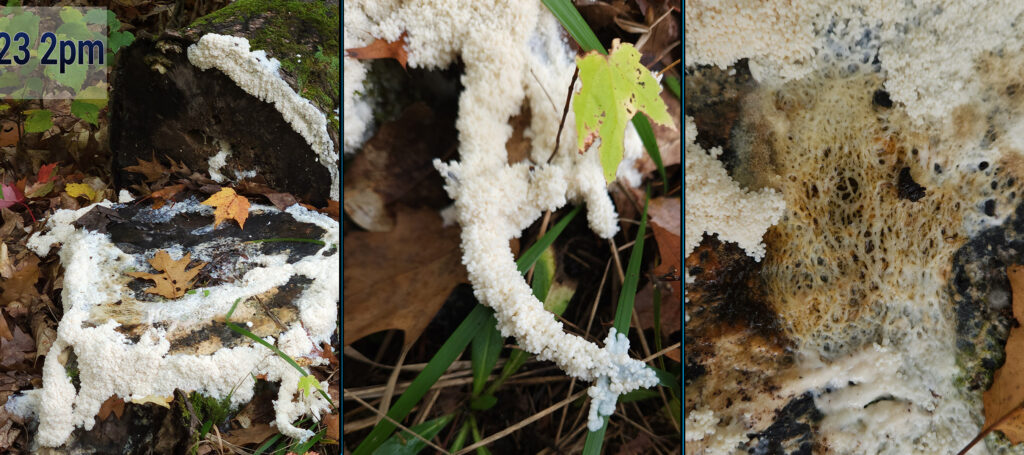
Left: Sept. 23, 2 p.m.: Mold can be found on the stump and on the log just behind the stump. Center: Sept. 23, 2 p.m.: A close-up photo shows that mold has engulfed a blade of grass. Right: Sept. 23, 2 p.m.: A close-up of cytoplasmic strands that make up the plasmodium and allow the slime mold to move or stream in a direction. / Photo Credit: Linda Williams, Wisconsin DNR.
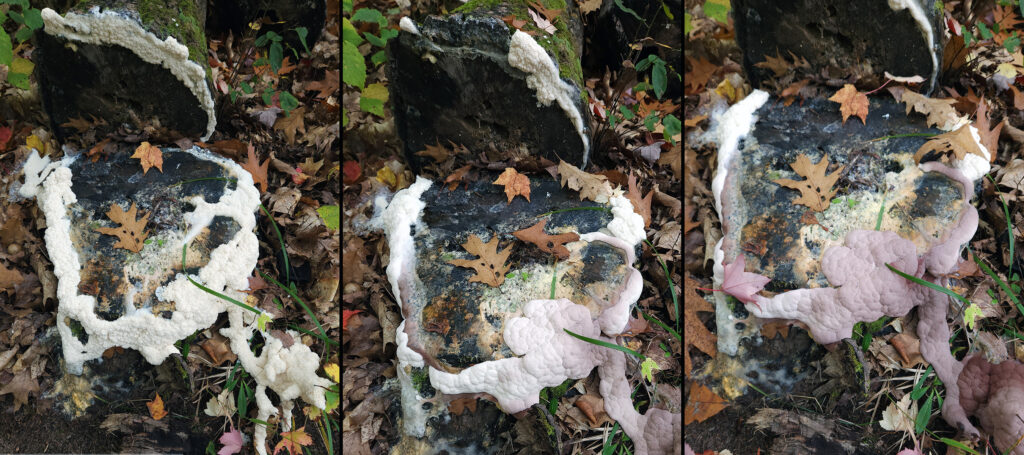
Left: 9 a.m. Sept. 28: The slime mold continues to move. Center: 1 p.m. Sept. 28: Slime mold has engulfed the grass. Right: 8 a.m. Sept. 29: The lower right area is organizing into structures that will eventually produce spores, and the slime mold on the log behind the stump has begun to move. / Photo Credit: Linda Williams, Wisconsin DNR
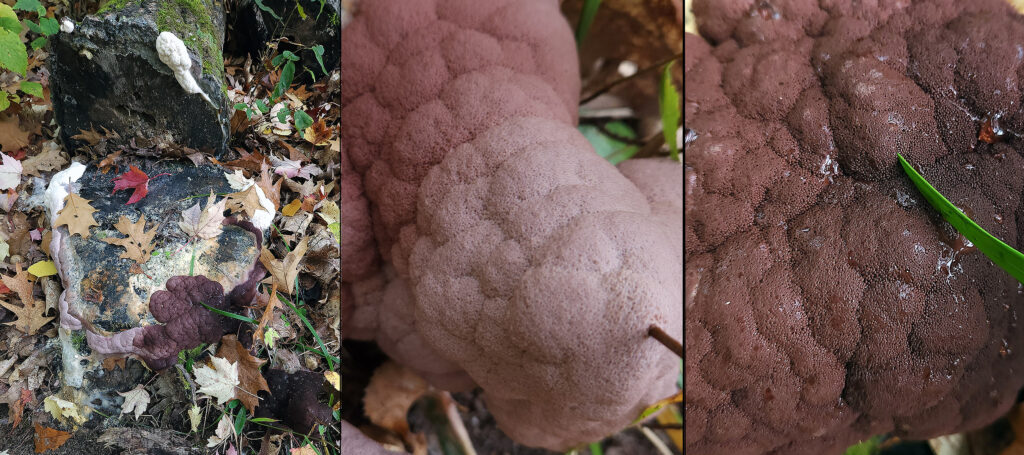
Left: 11 a.m. Sept. 30:Interesting colors begin to emerge. Center: 11 a.m. Sept. 29: A close-up of the area to the lower right of the stump shows slime mold engulfing a small stick. Right: 4 p.m. Sept. 29: Dark areas that will produce spores have begun to develop. / Photo Credit: Linda Williams, Wisconsin DNR
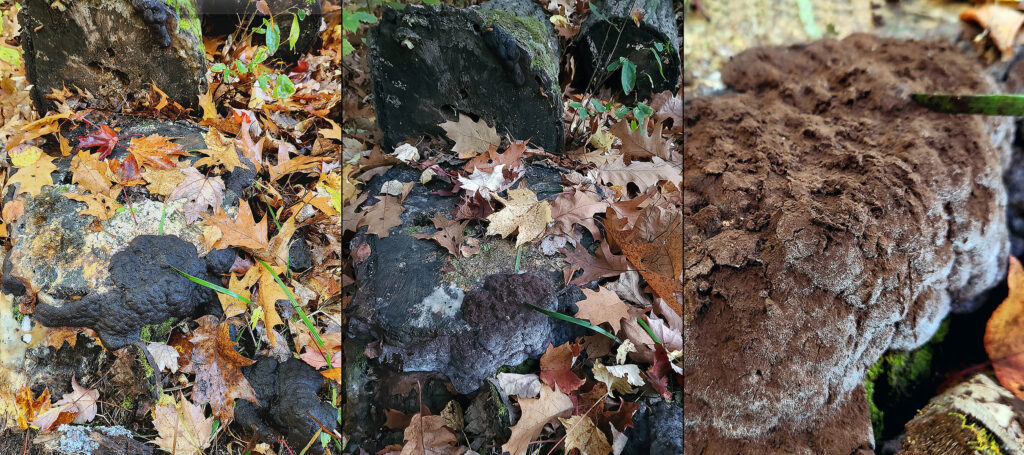
Left: 9 a.m. Oct. 1: Areas of the slime mold are very dark as they complete spore development. Parts of the slime mold had traveled 2 feet and were growing on a nearby stump. Center: 6 p.m. Oct. 4: Spores are being released from the dark areas. Right: 3 p.m. Oct. 5: Spores are being released as the slime mold dries out. / Photo Credit: Linda Williams, Wisconsin DNR
Various Appearances
Other examples of slime mold:

Three examples of what is called “dog vomit” slime mold found in the forest. This fungus is also sometimes called scrambled egg slime mold. / Photo Credit: Linda Williams, Wisconsin DNR
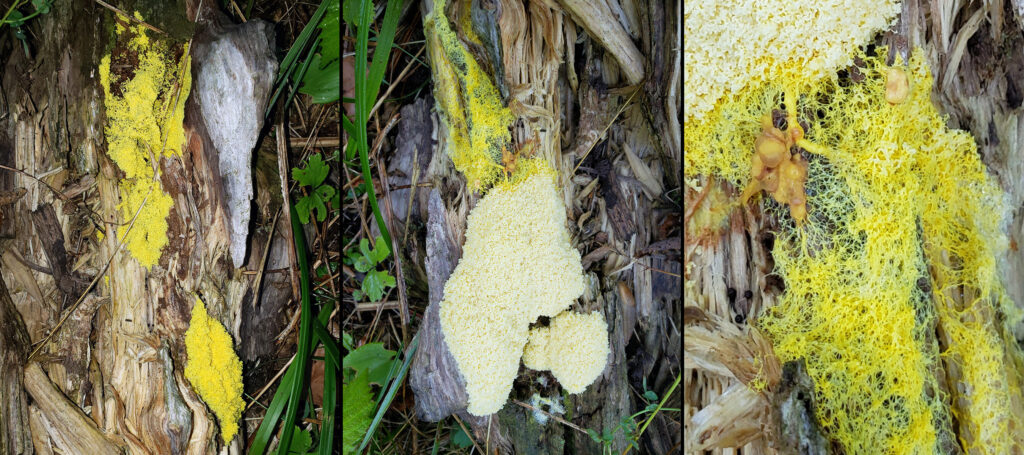
Slime mold on a log, Day 1 (left) and Day 2 (center and right). Notice on Day 2, the upper right area is a network of tubes (shown at right), allowing the plasmodium to stream to the better source of food on the left side of the log. / Photo Credit: Linda Williams, Wisconsin DNR
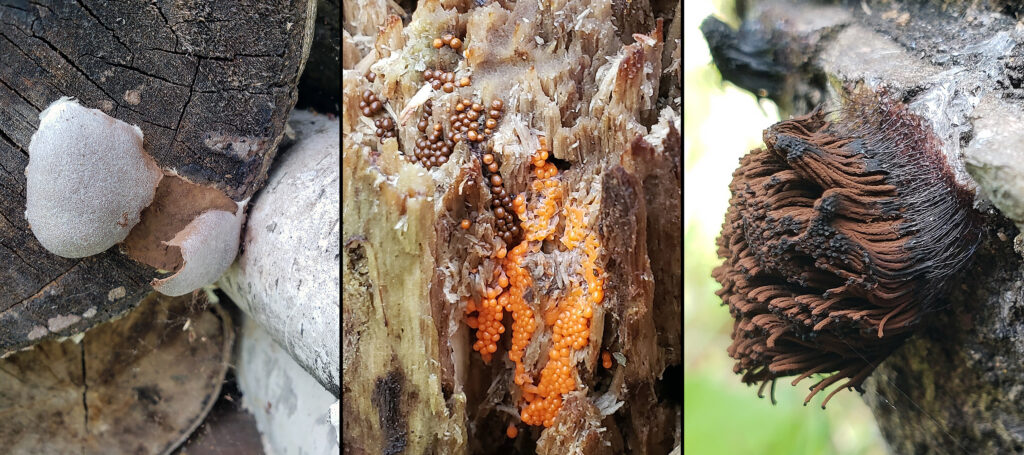
Other species of slime mold. From left to right: False puffball slime mold, probable insect-egg slime mold; and chocolate tube slime mold. / Photo Credit: Linda Williams, Wisconsin DNR
